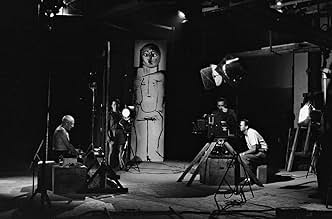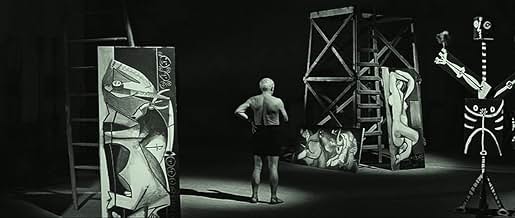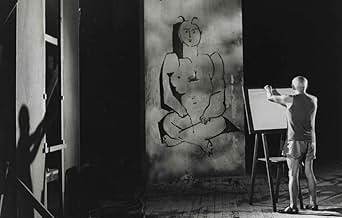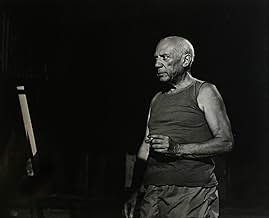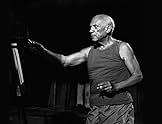IMDb-BEWERTUNG
7,5/10
2854
IHRE BEWERTUNG
Eine filmische Dokumentation über Pablo Picasso, wie er zahlreiche Leinwände für die Kamera bemalt, so dass wir an seinem kreativen Schaffensprozess teilhaben können.Eine filmische Dokumentation über Pablo Picasso, wie er zahlreiche Leinwände für die Kamera bemalt, so dass wir an seinem kreativen Schaffensprozess teilhaben können.Eine filmische Dokumentation über Pablo Picasso, wie er zahlreiche Leinwände für die Kamera bemalt, so dass wir an seinem kreativen Schaffensprozess teilhaben können.
- Regie
- Hauptbesetzung
- Auszeichnungen
- 1 Gewinn & 1 Nominierung insgesamt
Pablo Picasso
- Self
- (as Picasso)
Henri-Georges Clouzot
- Self
- (Nicht genannt)
Claude Renoir
- Self
- (Nicht genannt)
Empfohlene Bewertungen
A-one-of-a-kind look at the artistic process, the unique art documentary captures the creativity itself. Two friends, the great painter and the great director, Pablo Picasso and Henri-George Clouzot decided to do what Goethe's Faust had dreamed about - to capture and to store forever the moment of beauty and inspiration. Picasso conceives, sketches, and paints twenty canvases before our eyes as the camera rolls. The film did not solve the mystery of Picasso who had said about himself, "When I was 9 years old, I could paint like Rafael; as an adult, all my life I tried to learn how to paint like a child" but it lets us to be the eye-witnesses of the amazing process - the birth of twenty works of art into existence. Twenty exiting moments the only Artist could live through are captured forever for us to enjoy again and again. Clouzot uses a specially designed transparent 'canvas' to provide an unobstructed view and different techniques including slow motion animation to let the main character, the invisible Picasso's brush speak for itself. The film is accompanied by exquisite music and gorgeous photography by Claude Renoir, grandson of impressionist painter Pierre-Auguste Renoir and nephew of Jean Renoir. The paintings created by Picasso in the film cannot be seen anywhere else. They were destroyed upon completion of the film. The French government has taken over the preservation of the original negative and has declared this truly unique and priceless documentary a national (and I would call it an international) treasure.
Criterion DVD also includes "Guernica", a short documentary directed in 1950 by Alain Resnais before any of his feature films. Picasso's "Guernica" is one of the most famous paintings of the 20th Century which was created by the artist in response to bombing and destroying the ancient Basque town of Guernica by German aviation on April 27 1937 during Spanish Civil War. The painting is a passionate protest against war as well as the fascinating work of art. Resnais' 13 minutes short film is based on paintings, drawings, and sculptures by Pablo Picasso from 1902 until 949 including "Guernica" and is set against the ode written by French lyrical poet Paul Éluard and recited by Jacques Pruvost and María Casarès. In his early short film, Resnais already uses his famous jump cuts and cross-fades. "Guernica" is a valuable feature which goes well together with the marvelous "The Mystery of Picasso" and adds to understanding one of the most prolific and mysterious Artists of the last century.
Criterion DVD also includes "Guernica", a short documentary directed in 1950 by Alain Resnais before any of his feature films. Picasso's "Guernica" is one of the most famous paintings of the 20th Century which was created by the artist in response to bombing and destroying the ancient Basque town of Guernica by German aviation on April 27 1937 during Spanish Civil War. The painting is a passionate protest against war as well as the fascinating work of art. Resnais' 13 minutes short film is based on paintings, drawings, and sculptures by Pablo Picasso from 1902 until 949 including "Guernica" and is set against the ode written by French lyrical poet Paul Éluard and recited by Jacques Pruvost and María Casarès. In his early short film, Resnais already uses his famous jump cuts and cross-fades. "Guernica" is a valuable feature which goes well together with the marvelous "The Mystery of Picasso" and adds to understanding one of the most prolific and mysterious Artists of the last century.
Henri-Georges Clouzot, the French director of the masterpieces "Les Diaboliques" and "Le Salaire de la Peur" convinced his friend Pablo Picasso to make this documentary, painting twenty paints in front of the cameras. Using some special technique, Clouzot filmed from the other side of the canvas or stop-motion, and the result is this movie, where two geniuses are gathered: one behind and the other in front of the camera. In accordance with the information on the DVD, the canvases have been destroyed in the end of the shootings. Further, in 1984, the French government declared this documentary a national treasure. Clouzot and Picasso deserved this beautiful homage. My vote is eight.
Title (Brazil): "O Mistério de Picasso" ("The Mystery of Picasso")
Title (Brazil): "O Mistério de Picasso" ("The Mystery of Picasso")
Henri-Georges Clouzot's The Mystery of Picasso starts by announcing that we will have the pleasure of entering the mind of Pablo Picasso, seeing how he gets his creative inspiration; the film promises us that the only way to do this is to watch Picasso's hand. Picasso paints on paper that the ink bleeds through, putting the camera on the other side of Picasso's canvas and watching the a reversed version painting appear in a seemingly magical way. It becomes clear early on that Clouzot is not wholeheartedly trying to show us how Picasso gets his inspiration; that is a mystery. Clouzot wants to capture the joy of painting. That's what makes this film so entertaining: watching bizarre, beautiful images appear out of nowhere. Sometimes Clouzot uses jump-cuts to show us the different phases of a work in progress at a rapid-fire velocity and then reverses the painting in the same jump-cut technique, deconstructing Picasso's. This is all scored to fiery jazz music. We also see Picasso while painting, as his painting is timed. (Picasso has a great screen presence). Clouzot is equally concerned with deconstructing Picasso's work to understand what makes this fast-working artist tick, showing how impossible that task is, and wowing us all the way through. As far as wowing goes, Clouzot did a pretty good job, with scenes that ranged from unforgettable to pleasantly surprising.
One of the greatest filmmakers of France, Henri-Georges Clouzot, makes a film about his friend Pablo Picasso, perhaps the 20th Century's most renown artist. Clouzot begins with a proposition: if one were present at the conception of a great artistic masterpiece such as Mozart's Jupiter Symphony, and could peek inside the mind of the artist, what would one see? Fortunately, the visual art of painting offers a filmmaker that insight, and so Clouzot begins with Picasso in a dark room with white light directed at an empty canvas. The artist, like a bullfighter, confronts and ultimately displaces the empty space with drama and suspense. Clouzot takes a minimalist approach which chooses to focus on the art rather than the artist, and he achieves this objective by having Picasso sit on one side of a translucent canvas, and the camera on the other capturing only the ink or paint that has been administered, without the distraction or impediment of the artist - pure creation. A window into the mind of the artist! Twenty artworks are created in this manner, each being overlayed with the often suspenseful sounds of Georges Auric's excellent score. With THE MYSTERY OF PICASSO, art becomes exhilarating as one attempts to anticipate what Picasso will do next. "How will he resolve this problem?" Clouzot has created a priceless document for anyone seriously interested in art.
I've always known that Pablo Picasso was one of the most prolific characters of the 20th century. I've also heard about how this film was made many times before, that is with the translucent screen between the camera and Picasso. At the beginning I thought that it was a bit slow and I remember wondering if I was in the midst of 2 hours of Picasso drawing picture after picture. And indeed it was, with a few breaks where we actually see and hear Picasso interact with the camera men. But, amazingly, once you get into watching the short drawing exercises, it becomes very captivating. You aren't sure what he's drawing, and then a line and a squiggle later it is a bull or a woman or whatever. The most mesmerizing part though, as another writer said, was when he was painting the beach scene and he kept painting over his work over and over again. What he was painting over was amazing and it made you wonder why he felt like it just didn't work.
Wusstest du schon
- WissenswertesPablo Picasso is shown creating 20 drawings and paintings from start to finish. He allegedly destroyed these artworks afterwards so they would exist only in the film.
- Zitate
Pablo Picasso: I do not look for, I find!
- VerbindungenFeatured in Picasso (1985)
Top-Auswahl
Melde dich zum Bewerten an und greife auf die Watchlist für personalisierte Empfehlungen zu.
- How long is The Mystery of Picasso?Powered by Alexa
Details
- Erscheinungsdatum
- Herkunftsland
- Sprache
- Auch bekannt als
- The Mystery of Picasso
- Produktionsfirma
- Weitere beteiligte Unternehmen bei IMDbPro anzeigen
Box Office
- Bruttoertrag in den USA und Kanada
- 267.836 $
- Eröffnungswochenende in den USA und in Kanada
- 19.143 $
- 23. Feb. 1986
- Laufzeit
- 1 Std. 18 Min.(78 min)
- Farbe
Zu dieser Seite beitragen
Bearbeitung vorschlagen oder fehlenden Inhalt hinzufügen


